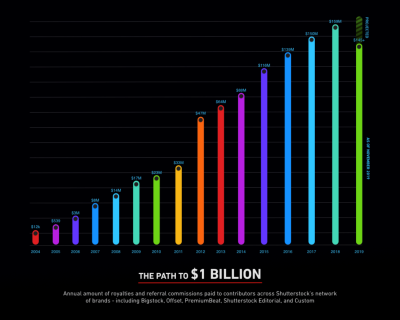Imagine having a vast library of high-quality images, videos, and music that anyone can access for their creative projects—that’s essentially what Shutterstock offers. Founded in 2003, Shutterstock has grown into one of the world’s leading stock content platforms, connecting talented contributors with businesses, marketers, designers, and creators worldwide. But how does a company like
Primary Revenue Streams of Shutterstock

Shutterstock’s revenue primarily comes from a few key sources, each playing a vital role in its overall financial health:
- Subscription Plans: The bread and butter for Shutterstock, these plans allow users to pay a fixed monthly or annual fee in exchange for a set number of downloads. Whether you’re a small business needing a handful of images or a large corporation requiring frequent content, subscriptions provide flexible options. They tend to generate consistent revenue and encourage ongoing customer engagement.
- On-Demand Purchases: Not everyone wants a subscription. Shutterstock also offers a pay-as-you-go model where users buy credits to download images or videos individually. This option appeals to those with sporadic needs or smaller projects, providing a quick revenue boost without long-term commitments.
- Contributor Licensing and Royalties: Shutterstock’s contributors upload their content and earn royalties whenever their work is downloaded. While this is a revenue-generating model for contributors, Shutterstock benefits by charging licensing fees for the content, which in turn boosts the company’s earnings. Essentially, Shutterstock acts as the middleman, making money from licensing fees while paying contributors a share of the revenue.
- Enterprise Solutions and Custom Licensing: For larger organizations or agencies, Shutterstock offers tailored licensing agreements, often with exclusive content or broader usage rights. These premium services come at a higher price point, adding another profitable revenue stream.
- Additional Services: Shutterstock also expands into related areas like editorial content, music licensing, and video production services, which diversify its income sources and tap into different markets.
By blending these revenue streams, Shutterstock creates a balanced and resilient business model. It ensures recurring income through subscriptions, attracts casual buyers with pay-per-download options, and leverages its vast contributor network to keep its content fresh and appealing. All of these pieces work together to keep Shutterstock’s financial engine humming along smoothly, making it a dominant player in the digital content space.
Subscription Plans and Pricing Strategies
When it comes to Shutterstock, one of the main ways they generate revenue is through their subscription plans. Think of these like memberships for businesses, designers, or anyone who needs a steady stream of high-quality images, videos, or music. The idea is simple: pay a regular fee, and in return, get access to a certain number of downloads each month.
Shutterstock offers several tiers of subscription plans to cater to different needs. For example, a small business might opt for a plan that allows 10 downloads per month, while a larger enterprise could go for a plan with hundreds of downloads. This tiered approach helps them attract a wide range of customers — from individual freelancers to big corporations.
Pricing strategies are carefully crafted to balance affordability with value. Typically, the more downloads you commit to upfront, the lower the cost per asset. This is called volume discounting, and it encourages users to purchase larger plans. Plus, it’s a win-win: Shutterstock secures predictable revenue, and customers get a better deal for committing long-term.
Another clever tactic is offering different subscription types, such as:
- Monthly plans: billed every month, great for ongoing projects.
- Annual plans: paid once a year for a discounted rate, perfect for long-term campaigns.
Interestingly, Shutterstock also experiments with flexible plans that allow users to pause or upgrade their subscriptions based on their workflow. This flexibility keeps customers happy and loyal, making it more likely they’ll stick around and keep paying over time.
From Shutterstock’s perspective, subscription plans help smooth out revenue streams and increase customer lifetime value. They also provide valuable data about customer preferences and usage patterns, which can inform future product offerings or promotional campaigns. Overall, tiered subscriptions and smart pricing strategies are a cornerstone of Shutterstock’s business model, helping them grow and adapt to a constantly changing digital marketplace.
Pay-Per-Download Options and Licensing Fees
While subscriptions are popular, Shutterstock also makes money through a pay-per-download model. This approach is perfect for customers who need just a few assets now and then or prefer more flexibility without committing to a subscription. With pay-per-download, users simply select the images or videos they want and pay a set fee for each one.
This model is especially appealing to occasional users or those working on one-off projects. It’s straightforward: browse the platform, choose what you like, and pay the licensing fee to use the content legally.
Speaking of licensing, Shutterstock offers different types of licenses, which directly impact the licensing fees:
| Type of License | Description | Typical Use |
|---|---|---|
| Standard License | Allows use of assets for most commercial purposes, like marketing, social media, and advertising, with certain limitations on distribution and copies. | Most common, suitable for blogs, social media posts, and small campaigns. |
| Enhanced License | Provides broader rights, including unlimited reproductions, use in merchandise, or large-scale campaigns. | Big advertising campaigns, product packaging, or merchandise production. |
The licensing fees vary based on the type of license, the resolution or size of the asset, and how you plan to use it. For example, a high-resolution image for a billboard will cost more than a small social media graphic. Shutterstock’s pricing system is transparent, so customers know exactly what they’re paying for.
One interesting thing about this model is that it allows Shutterstock to tap into different customer segments. While some prefer subscriptions for regular use, others find pay-per-download more cost-effective for their specific needs. Plus, licensing fees contribute significantly to Shutterstock’s revenue, especially when high-value licenses are sold for commercial or large-scale uses.
In summary, Shutterstock’s combination of subscription plans and pay-per-download licensing creates a flexible ecosystem. This dual approach ensures they can serve a broad customer base while maximizing revenue from each asset sold. Whether customers choose a regular subscription or pay as they go, Shutterstock has built a robust system that keeps their business thriving in the competitive stock media market.
Additional Services and Revenue Opportunities
While Shutterstock is best known for its vast library of stock images, videos, and music, the company has cleverly diversified its offerings to generate multiple streams of revenue. This approach not only broadens its market reach but also creates new opportunities for growth and stability.
One of the key avenues is Shutterstock Editorial, which provides licensed images and videos for news outlets, publishers, and media organizations. This service taps into the fast-paced world of news and current events, where timely, relevant visuals are in high demand.
Another significant revenue stream comes from Shutterstock Custom, a platform that connects brands with professional photographers and videographers for bespoke content creation. This service is perfect for companies needing unique, tailored visuals that stand out from stock imagery. It’s a win-win: clients get custom content, and Shutterstock earns from the project commissions.
Plus, Shutterstock has ventured into editorial and enterprise solutions. These include subscription plans tailored for large organizations, agencies, and media companies that require extensive and ongoing access to content. These bulk plans often come with volume discounts, encouraging larger purchases and fostering long-term relationships.
Beyond content licensing, Shutterstock offers tools and platforms like Shutterstock Editor, a user-friendly online editor allowing customers to customize images directly on the site. This service adds value and encourages repeat business, as users can tweak visuals to fit their exact needs without leaving the platform.
Furthermore, Shutterstock has been exploring partnerships and integrations with other platforms, such as design tools, social media management apps, and marketing platforms. These integrations make it easier for users to access Shutterstock’s content seamlessly within their existing workflows, increasing usage and, consequently, revenue.
And let’s not forget the power of subscriptions and licensing models. Shutterstock offers flexible plans—from pay-per-image options to unlimited downloads for subscribers—which cater to different customer needs and budgets. This versatility helps attract a broad customer base, from individual bloggers to large corporations.
In summary, Shutterstock’s ability to offer a wide range of services—from stock content to custom solutions and integrated tools—creates multiple revenue opportunities. This diversification not only boosts earnings but also helps the company stay resilient against market fluctuations in any single segment.
Factors Contributing to Shutterstock’s Business Success
Shutterstock’s journey to becoming a powerhouse in the digital content industry didn’t happen by chance. Several key factors have played a role in its ongoing success and growth, making it a favorite among creators, businesses, and consumers alike.
First and foremost, massive content library is at the heart of Shutterstock’s success. With millions of images, videos, and music tracks, the platform offers something for almost every need. This extensive collection attracts a diverse user base and keeps customers coming back, knowing they can find what they’re looking for all in one place.
Secondly, the company’s user-friendly platform makes searching, licensing, and downloading content straightforward—even for beginners. Intuitive interfaces, robust search filters, and helpful tools like AI-powered recommendations make the experience smooth and enjoyable.
Another big factor is pricing flexibility. Shutterstock offers various plans—from pay-as-you-go options to unlimited subscriptions—catering to individuals, small businesses, and large enterprises. This adaptability ensures broad accessibility and helps attract a wide range of customers.
Innovation has also been crucial. Shutterstock invests heavily in technology and AI to improve search accuracy, content tagging, and user experience. For example, AI-driven image recognition helps users find similar images quickly, saving time and increasing satisfaction.
Moreover, global reach and localization have expanded Shutterstock’s footprint worldwide. Multilingual interfaces, localized content, and region-specific licensing make it easier for international users to access and use the platform, broadening its market significantly.
The company’s community and contributor network are equally vital. Shutterstock has built a large, engaged community of photographers, videographers, and musicians who regularly contribute new content. This continuous inflow keeps the platform fresh and competitive, while contributors earn fair royalties, creating a sustainable ecosystem.
Lastly, Shutterstock’s brand reputation as a reliable, high-quality content provider fosters trust among users. Consistent quality control, licensing clarity, and excellent customer support help maintain that reputation and encourage loyalty.
In essence, Shutterstock’s success is the result of strategic diversification, technological innovation, a massive and diverse content library, and a focus on user experience. These factors work together to keep the platform relevant, competitive, and poised for future growth.
Conclusion and Future Outlook for Shutterstock
Shutterstock has established itself as a leading player in the stock media industry by diversifying its revenue streams and leveraging innovative technology. Its core business model, centered around licensing high-quality images, videos, and music, continues to generate consistent revenue. The company’s expansion into subscription plans, enterprise solutions, and custom content services has further strengthened its market position.
Looking ahead, Shutterstock is well-positioned to capitalize on emerging trends such as artificial intelligence, machine learning, and augmented reality, which can enhance content personalization and search capabilities. The company’s investments in AI-driven content creation and curation tools could open new revenue channels and improve user experience. Additionally, with the growing demand for digital content across various industries—from marketing to entertainment—Shutterstock’s platform is poised for sustained growth.
However, the industry also faces challenges, including intense competition from free or low-cost alternatives, copyright concerns, and evolving consumer preferences. To stay ahead, Shutterstock must continue innovating, expand its global footprint, and diversify its offerings to meet the changing needs of creators and consumers alike.
In conclusion, Shutterstock’s strong foundation, combined with its strategic initiatives and technological advancements, bodes well for its future. By adapting to industry trends and addressing potential challenges proactively, the company is likely to maintain its revenue growth and reinforce its position as a leader in the digital media marketplace.


